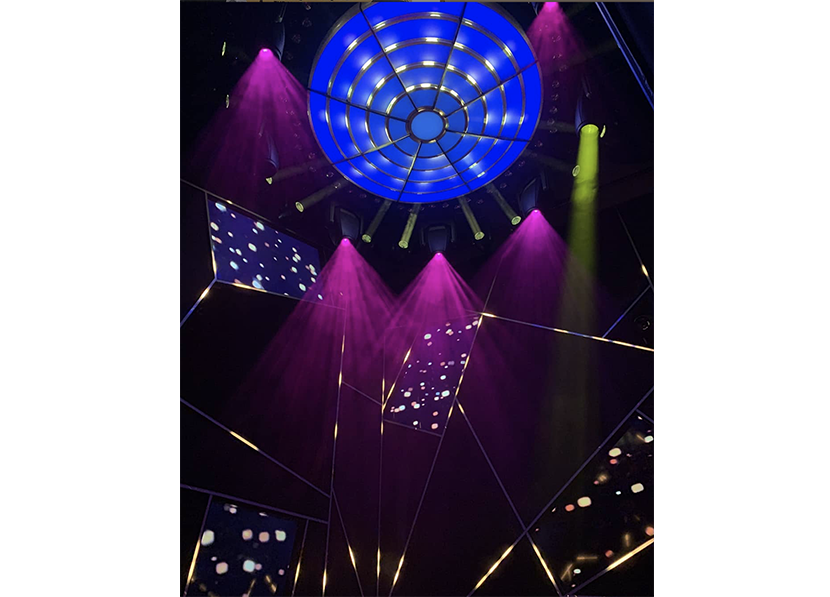Kids become heroes on Pip’s Island, a custom-built flagship attraction in New York, which is currently in previews and will officially open to the public on May 20. Conceived and designed by its three founders, CEO Rami Ajami, Chief Creative Officer Rania Ajami, and creative director Walter Krudop, Pip’s Island combines innovative puppetry, digital animation, cutting-edge technology, and live actors to create an immersive theatrical adventure for young audiences and families. On a journey through thematic rooms, children earn achievement badges called "sparks," which they can use to save the island's inhabitants from the darkness of the villain, Joules Volter, who has taken over the Lighthouse, the island's energy source.
Read our in-depth look of Al Crawford's lighting design and the immersive set design here.
The Video Design
Projection designer Rocco DiSanti was there for Pip’s world premiere in 2016, and the video design has changed much since then. The last scene in particular, which always had the most video and still does, has evolved dramatically. In 2016, the young explorers watched a video that shared the story of the ultimate Lighthouse battle. This time, the video assists the explorers as they enact the storytelling. In one scene, Joules Volter appears on all eight of the screens (four 75'' and four 82'' which are mapped in 3D space in Dataton Watchout), and the kids must fire at him with their spark energy until he is defeated. “The kids do action, and the action is reflected on the screens,” DiSanti explains. “Instead of having them sit and watch a cartoon, we have this interaction between the video and the children.”
A team of animators, led by creative director Walter Krudop, created the animations in Autodesk Maya 3D software and compositing in Adobe After Effects. “Moving comic books are the inspiration for the video content,” explains Krudop. “Colors for animated content are based off the bold, vibrant hues of comic books. Along with the lights, they bring the audience into each scene. We want the audience to join in the battle between hero and villain from every angle of the set.” A character can go from a live actor to a puppet to an animation and back again. The team of animators masterfully keep all those versions of a single character authentic.

Sound, video, and lighting all play off of each other in this experience. “I had a video with these shimmering particle effects moving around all the screens in the Lighthouse, swooping around so that it is one gigantic video surface,” says DiSanti. Zak Al-Alami programmed the LEDs on the frames via the Madrix system to match the effect. In another scene, DiSanti created a video wipe that goes from the bottom to the top in color, and he mimicked that, too. “We would always play off each other. We always talked about how we can make everything be one cohesive design.”

DiSanti selected laser projectors throughout the space due to their low maintenance and quiet attributes. In the first room, the Map Room, where explorers get their legendariums and vests, is a Panasonic 7.5K laser projector that displays the informational video from the leader of the Exceptional Explorer Society, detailing the plight of the island and its Lighthouse. In the Meadow room, a Vivitek 18K laser projector in portrait orientation is hung sideways to project a waterfall onto the tall, curling, dichroic panel back-painted white.

Originally, the team planned to place a big, flat screen TV in a wooden box to disguise it as an old CRT TV in Mrs. Grumble Plum’s room. “But then we thought this kind of ruins the composition of this beautifully curated room with its shelves of bakery items and line art on the walls,” explains DiSanti. “So I got this little cheap Pico projector and hid it in the set. I projected it onto the wall, and we drew a TV around the projections, and then I mapped it to that. It turned out really, really great.”
Since the Pico projector is consumer class, it does not have any of the control options like those of a professional. “I ended up making a WiFi to infrared device out of a cheap microcontroller that I could send commands to and then it would send IR commands and act like a remote control to turn on the projector every day and switch it to the correct source.”

Media display is run through Dataton Watchout, and since the show pulses, with multiple groups going through the experience at different stages simultaneously, each Watchout system is its own standalone system. “There's actually four Watchout clusters in the show that are all operated independently,” DiSanti explains. “That way, no matter where any other audience is in the space, it doesn't matter because the ShowPulse show control system triggers everything reliably.” Each Watchout system is run headless without a production machine. “It's just the display machines getting commands. So you just turn on the rack, and it's ready to go. It's a pretty slick system.”
DiSanti tips his hat to his assitant Shelby Reilly, who went above and beyond to keep things moving during tech, as well as Brett Jarvis, sound designer and show control designer for Pip’s Island. “Whenever I'm asked, ‘what's the most important aspects of the video?’ My answer most of the time is going to be the sound design. It was really a pleasure working with Brett because I would go to him and say, ‘This moment in the video is not working. I need some help from you,’ and he would add some sound effects or a little moment to really drive the video, and that will make or break a video design. That's what was really great about this process was that Brett understood that and really stepped up and helped the design really work.”
Stay tuned for more on the sound design and show control for Pip's Island.